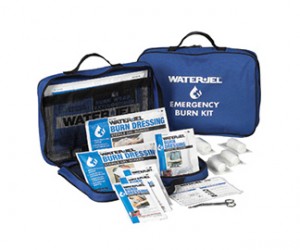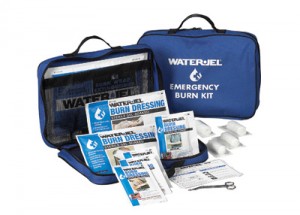First Aid for Burns
The information contained within this article will assist you in identifying the cause, severity and percentage of a burn. It is important that you do not attempt to treat a burn until you are certain any potential hazards have been neutralized.
1) Classification for Burns
Superficial
1. Reddening and discolouration of the skin
2. Some swelling
3. Pain
Partial thickness
1. A combination of discolouration, swelling and blistering of the skin
2. If any blisters have burst a clear watery fluid from the site (Serum)
3. May involve one or more blisters being formed
4. Pain
Full thickness
1. Pitted/charred appearance
2. Surrounding skin around burn site may appear wax-like and false
3. Clear watery fluid may leak directly from the burn site
4. Blisters may form around the site of the main charred area but not on it
5. If the skin is badly charred, the casualty may not experience pain as the nerve endings may be destroyed
2) Treatment of burns
1. Ensure that the cause of the burn does not endanger your life or that of the casualty
2. Assess that the casualty is still conscious (if they are not, carry out the ABC of resuscitation)
3. Establish the cause of the burn – if a chemical is suspected go to section 4
4. Immediately begin to cool the burn. Continue cooling under water for 10 minutes.
NB – DO NOT over cool, you may lower the body temperature too much.
5. If the burn has affected a limb e.g. arm, remove any constrictive items such as watches, rings etc., in anticipation of any swelling.
NB – DO NOT remove if directly in contact with the burn.
6. Initially cool under running water for 10 minutes or until burning sensation has stopped and then apply a non adhesive sterile dressing.
3) Dressing a Burn
1. When a burn has been cooled sufficiently a sterile non fluffy dressing should be applied.
2. Gently remove any rings, watches, belts, shoes or smouldering clothes from the injured area before it begins to swell.
NB – If Clothing is burnt onto the wound DO NOT pull off.
3. A water based gel soaked sterile dressing is ideal as it helps prevent burn-progression and infection.
4. If a suitable dressing is not available, you may improvise using a sterile triangular bandage or cling film.
DO NOT apply any dressings that may cause a tourniquet effect.
4) Clothing on Fire
If a casualty’s clothing is on fire the greatest danger will be to their airway. Due to a combination of panic and pain they may be on their feet and moving flames will naturally rise and endanger the airway of the casualty.
Action to take
1. Initiate the fire alarm.
2. Attempt to get the casualty flat on the floor – you may have to physically push them over using using a broom or fire blanket, etc. to ensure you do not get exposed to the flames.
3. Once the casualty is flat on the floor try to smoother the flames. Ideally use a fire blanket or improvise with a woolen or cotton blanket.
4. Ensure the casualty’s Airway, Breathing and Circulation are present.
5. Cool the burn(s).
NB – DO NOT over cool, you may lower the body temperature too much. DO NOT roll the casualty. Extinguish from the head down.
5) Complicated burns
Airway
All burns involving the airway are potentially life threatening. Attempt to treat any external burns and dial 999/112 for help.
Burns to the respiratory system
As well as sustaining a damaged airway, the lungs and associated tissue may be damaged by hot fumes and smoke. This may cause blistering to the tissue and requires urgent medical attention.
Circulation
Normally resulting from chemical contamination, a circle burn involves damage to the skin that encircles any part of the body such as the arm. As it swells it constricts circulation of other body systems. Treat as in section 3 and dial 999/112 for help.
6) Burn severity
The severity of burns depends on the area of the body affected and the extent i.e. Partial thickness or Full thickness.
1% OF THE BODY’S SURFACE IS ROUGHLY EQUIVALENT TO THE PALM OF THE CASUALTY’S HAND. CASUALTIES SHOULD BE REFERRED TO HOSPITAL IN THE FOLLOWING CIRCUMSTANCES:
- Any Superficial burn covering more than 5% of the body’s surface.
- Any Partial thickness burn covering more than 1% of the body’s surface.
- Any Full thickness burns. Any burns involving children.
- All burns involving feet, hands, face or genital areas.
- All burns that extend around a limb.
- Any burns with a mixed pattern of depth.
- If unsure of depth or severity of burn.
For a full range of Burn Care products visit https://www.scullyfirstaidsupplies.ie/types/burn-care/



